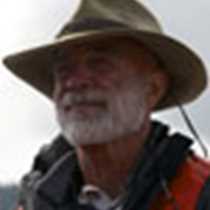Iyoukeen Cove and Pavlof Harbor
It was an honest to goodness Southeast Alaska day…no overrated sunshine and blue skies. Good old wind and rain and beautiful clouds…gray on gray! The day started this way and ended this way, with only changes in wind intensity and rain density.
Our expedition leader woke us early this morning because we had two humpback whales that just couldn’t get enough of the wind, rain and fresh air…they breached over and over and over for an hour. A few times they breached almost within our reach. An official breach requires that the whale come two-thirds out of the water and do at least a half twist in the air. These whales far exceeded the minimum. During the later morning we watched a variety of humpbacks in the area of Iyoukeen Cove swimming close by, blowing their mighty spouts and throwing their huge flukes high in the air as they dove below the surface to do whale business in the deep. Even though the weather was a bit ghastly, most of us spent a lot of time on deck marveling at the antics of these giant leviathans.
After lunch the National Geographic Sea Lion moved a ways south along the coast to Pavlof Harbor, on the edge of Freshwater bay, and dropped anchor just off one of the prime salmon streams here in Southeast Alaska. Many of us took hikes, whether along the stream, into the forest or around the lakeshore, we all got a feel for the dense and fascinating temperate rainforest ecosystems. Others took tours by Zodiac and a few hearty souls went out on the kayaks in the rain.
It was pink salmon that were frequenting the stream, many of them spawned out and dying. Pinks, or humpback salmon, are the most abundant Pacific salmon in North America and Asia and have the simplest and shortest life cycle. When the young emerge from the gravel in the spring, they quickly go to sea, grow rapidly for 18 months and then return here to their natal stream to spawn and die. The male courts the female while she digs a nest and he crosses back and forth over her tail, his body quivering. When she is ready to release her 1,500 to 2,000 eggs, he moves alongside and they both release their reproductive products while vibrating their tails and anal fins. The male looks very much like the female until just a few weeks before returning to the stream of his birth, when an amazing metamorphosis takes place. He develops an enormous hump on his back, a greatly enlarged head, large upper and lower teeth and a pronounced hook to his snout. Both bears and eagles thrive on pink salmon, especially newly fledged young eagles that are not very good at fishing; they can feast on the dead salmon carcasses from mid-August through October.
Later in the afternoon, the National Geographic Sea Lion returned to Iyoukeen Cove on the chance that we might see cooperative feeding humpbacks. And, sure enough, after about an hour of watching whales gather into a cohesive group, we saw six, and then eight, whales all coming out of the water at once, with herring flying in all directions. We also heard their haunting call through our underwater microphone. This is arguably one of the greatest wildlife spectacles in the world.
What a great start to our voyage of discovery in Southeast Alaska.




